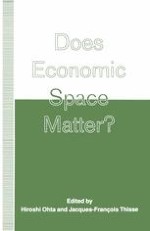1993 | OriginalPaper | Buchkapitel
Innovation and Location: Spatial Agglomeration and Deglomeration
verfasst von : Tatsuhiko Kawashima
Erschienen in: Does Economic Space Matter?
Verlag: Palgrave Macmillan UK
Enthalten in: Professional Book Archive
Aktivieren Sie unsere intelligente Suche, um passende Fachinhalte oder Patente zu finden.
Wählen Sie Textabschnitte aus um mit Künstlicher Intelligenz passenden Patente zu finden. powered by
Markieren Sie Textabschnitte, um KI-gestützt weitere passende Inhalte zu finden. powered by
Let us begin with a naive story about an imaginary country named Webertopia. This country is situated along a very narrow valley-corridor h kilometres in length, which makes the geographical territory of Webertopia appear as if it is a horizontal line. At one end of the valley-corridor exists city A which sits continguous to the boundary of country AA, while city B sits at the other end of the corridor contiguous to country BB. In city A, a licensed factory M A produces the fixed amount q z of commodity z every day for export to country AA. In city B, we have a licensed factory M B producing daily the amount q z of z for export to country BB. The conditions of the licence issued to M A require that the commodity z produced by M A should be sold at a fixed unit price p z to an importer I A from country AA who comes to city A every day to purchase the product. The similar conditions must be met by factory M B with respect to importer I B from country BB. The average cost to produce commodity z is c1 for both factories when they are operated separately. If the two factories were to go into joint production at a single location within the national boundary of Webertopia, the average production cost would turn out to be c2.
